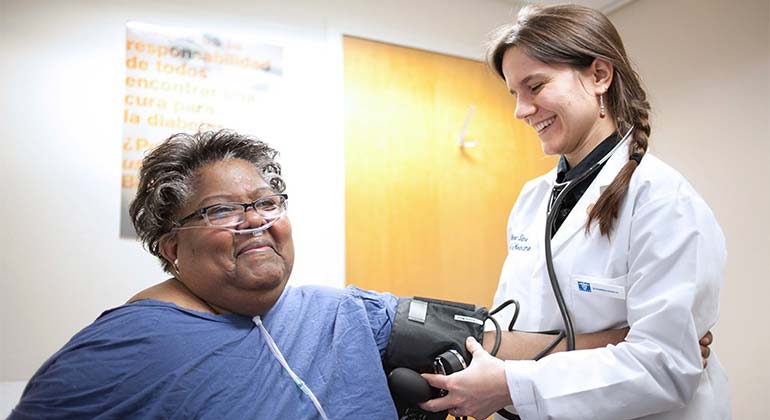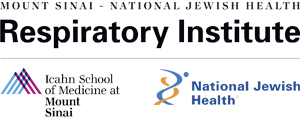
Pulmonary Fibrosis/Interstitial Lung Disease Program
The Pulmonary Fibrosis/Interstitial Lung Disease Program at The Respiratory Institute treats patients with the full spectrum of interstitial lung disease (ILD), idiopathic pulmonary fibrosis (IPF), and related conditions. Patients with these conditions require specific medical attention, close follow-up, and associated services to optimize management of the disease and patient’s well –being and quality of life. At Mount Sinai, we provide diagnostic evaluation, therapeutic interventions and compassionate, state of the art comprehensive care for the patient with diffuse lung disease and we advance knowledge of the field through education and research.
We provide exceptional care to patients through the application of advanced multidisciplinary conference and approaches to accurate diagnosis and management of IPF and ILD. Our specialists promote the health as well as physical and emotional well-being of patients by offering a unique environment where clinical and translational research, diagnosis, management, and education are seamlessly integrated.
Idiopathic Pulmonary Fibrosis
There are multiple types of pulmonary fibrosis that our patients may encounter. Of these the most serious is that known as Idiopathic Pulmonary Fibrosis. This diagnosis requires the exclusion of known causes of or associations with the other types of pulmonary fibrosis (PF). These types of PF include:
- Interstitial lung disease is a common manifestation of collagen vascular diseases such as rheumatoid arthritis, scleroderma, and dermatomyositis. The various patterns of interstitial lung diseases, including fibrosis can be appreciated in these disorders
- Pulmonary Fibrosis caused by chronic inhalation of agents that injure the lung, by causing inflammation and eventually leading to scarring (fibrosis) of the lung. Among these agents are dust, organic, and inorganic particles such as bird droppings, mold, and other particles that may induce allergic reaction in the lung.
- During the course of work or in a patients’ occupation, exposure to dust such as silica, metals or asbestos can lead to fibrosis. Certain medications are capable of provoking inflammatory and fibrotic reactions in the lung (amiodarone, nitrofurantoin, and bleomycin). Radiation therapy may also have secondary effects that result in pulmonary fibrosis. Once we have excluded other potential causes for fibrosis and the CT scan and/or biopsy supports the diagnosis, we determine that the patient has Idiopathic Pulmonary Fibrosis (IPF)
Symptoms of Idiopathic Pulmonary Fibrosis (IPF)
If you have idiopathic pulmonary fibrosis, you most likely will experience some or all of the following symptoms:
- Chronic, dry cough due to the scar tissue
- Shortness of breath, especially when exercising or carrying out your activities of daily living
- Weakness and fatigue
Causes of Idiopathic Pulmonary Fibrosis
Idiopathic Pulmonary fibrosis (IPF) is a chronic lung disease that occurs predominantly in older adults. The diagnosis is established by a pattern of usual interstitial pneumonia (UIP) either by high resolution CT scan of the chest (HRCT) or by histologic evidence of UIP, and exclusion of alternative causes (such as connective tissue disease, chronic hypersensitivity pneumonitis, occupational lung diseases, and drug toxicity).
There are factors associated with IPF:
- Genetics, there is a familial predisposition for this disease in some patients
- Smoking increases the risk of developing IPF
- Infections, particularly certain viral infections may increase the risk
- Certain occupations such carpentry are at increased risk of IPF
- GERD (gastroesophageal reflux disease) has been associated with IPF
After many clinical trials, two medications were approved for the treatment of IPF in 2014. The approved agents represent the first therapies for this disease. While holding promise for slowing the disease and improve the outcomes in our patients with pulmonary fibrosis, the quest continues for agents that will arrest or reverse the damage in IPF. On-going clinical trials seek to find more efficacious therapies. We also continue to treat and manage the co-morbidities that affect patients suffering with this illness in order to improve quality of life and survival, our ultimate goal.
Treatments for Idiopathic Pulmonary Fibrosis
There is no known cure for IPF. However, at Mount Sinai we offer wide variety of treatments to provide you with the very best pulmonary fibrosis care
- Antifibrotic therapy
- Oxygen therapy
- Participation in Clinical Trials
- Physical rehabilitation
- Referral to Lung transplantation
- Support Groups
Interstitial Lung Disease
Our Interstitial Lung Disease (ILD) Program is a multidisciplinary program dedicated to the comprehensive care of patients with various forms of these illnesses; to the application of the latest therapeutic advances and to promoting progress through clinical and basic research.
The interstitial or diffuse lung diseases are a diverse and large group (more than 200) of pulmonary disorders that have similar symptoms and radiographic presentation. They are called “interstitial” because they affect predominantly the edges or borders of the lung where the tissues’ elements that support the air sacs (functional units of the lung) are located. This is the “interstitium” or the “in-between tissue” space.
The course of these illnesses is as variable as are the many causes of these diseases. Some resolve with zero to minimal treatment. Others may require more intensive treatment and still others may progress to an advanced stage with fibrosis or scarring of the lungs, with chronic cough and breathing problems.
The diagnosis of the individual disease can be challenging and requires detailed clinical investigation and an interdisciplinary team with expertise in this field. Treatment and support of the patient demands the same commitment and expertise. The treatment of interstitial lung diseases other than IPF may require the use of steroids, anti-inflammatory and immunosuppressive medications. The importance of distinguishing and accurately diagnosing these diseases, cannot be overemphasized.
The Interstitial Lung Disease Program provides care in a multidisciplinary facility with access to experts in the field, full pulmonary function studies, radiographic imaging, interventional and diagnostic modalities, and educational resources on diseases and therapeutic options, including discussions on clinical trials. Prior records, imaging and biopsy specimens are reviewed to confirm or establish diagnoses in Multidisciplinary Discussions (MDD). An initial consultation may last several hours during which time information previously gathered is reviewed, comprehensive medical history, examination and pulmonary function studies are obtained. Once a diagnosis is established and any associated illnesses are addressed, individualized treatment plans are developed between the medical staff and patient.
Types of Interstitial Lung Disease
Some forms of interstitial lung disease include:
- Eosinophilic Pneumonia ( a form of allergic pneumonia)
- Hypersensitivity Pneumonitis (HSP)
- Lymphangioleiomyomatosis (LAM)
- Langerhans Cell Hystiocytosis (LCH)
- Pulmonary Fibrosis
- Associated with certain connective tissue diseases such as scleroderma, rheumatoid arthritis, dermatomyositis or other forms of immunologic disorders
- Associated with genetic diseases such as Hermansky Pudlak Syndrome, Gaucher’s
- Idiopathic Pulmonary Fibrosis (IPF) Idiopathic means of unknown cause
- With known exposure: metal dust, wood dust, radiation, asbestos, some medicines, fumes
- Sarcoidosis
- World Trade Center Associated Lung diseases
Treatments for Interstitial Lung Disease
The Interstitial Lung Disease Program offers a variety of treatment options for you. We primarily use pirfenidone or nintedanib to treat IPF. These antifibrotic agents slow down the progression of disease. They represent the first proven therapy for IPF and we continue to research additional treatment options with our ongoing clinical trials.
The evaluation begins with a physician or self-referral to our program. After you fill out questionnaires that have been mailed to you and provide medical records, imaging and biopsy slides (if available), we can set up your appointment. During your consultation, you will meet with one or more of the physicians, nurses, medical assistants, pulmonary function and radiology technicians, clinical research coordinators (if appropriate), and the secretarial and administrative staff.
A detailed medical history and thorough physical examination will be performed, which may include a radiograph test. We will sit down with you to review all your information and imaging and discuss the results of testing and develop a personalized treatment plan to best fit your needs. A return appointment may be necessary to complete the evaluation and we will then forward a report to your physician.
In order to establish a diagnosis, you may need to undergo one or several of the following tests or procedures. These include but are not limited to:
- Blood tests
- Bronchoscopy with biopsy and/or bronchioalveolar lavage ( a wash of the lung tissue accomplished via the bronchoscope)
- CT scan with ILD protocol, if indicated
- Exercise study
- Lung volume measurement
- Oxygen saturation assessment in 6 MWT
- Pulmonary function tests: spirometry, diffusing capacity, measurement of lung volumes)
- Radiographic imaging: chest x-ray and/or additional CAT scan of the chest
- Possible Surgical lung biopsy (often video-assisted)
- Other tests may be required (echocardiogram, cardiac catheterization, ventilation/perfusion sans, PET scans, etc.)
We will offer you the opportunity to participate in the ILD Registry and you will learn about our ongoing clinical trials. In terms of treating interstitial lung diseases, we employ a variety of specific treatments and strategies that are personalized based upon your diagnosis and symptoms. Often, our patients are facing an ILD diagnosis in conjunction with connective tissue diseases such as scleroderma, rheumatoid arthritis, lupus, vasculitis, myositis, drug-induced lung disease, hypersensitivity pneumonitis, and World Trade Center-associated lung disease. This comprehensive approach to care leads to improved outcomes and survival rates for patients with IPF and ILD.
Why Mount Sinai–National Jewish Health Respiratory Institute
National Jewish Health, the nation’s leading respiratory hospital, has partnered with the Mount Sinai Health System to create the Mount Sinai – National Jewish Health Respiratory Institute. We focus on evaluating, treating, and managing interstitial lung disease and pulmonary fibrosis. We strive to give you the best possible quality of life. We provide consultations, review of your records, and physician referrals. Our program participates in clinical trials, which means that you can receive the very latest treatments, if appropriate. We have been involved in developing some of the most important medication therapies. Our team approach offers the most promising state-of-the-art therapies. We pride ourselves on patient education to help you understand your condition and its treatment.
